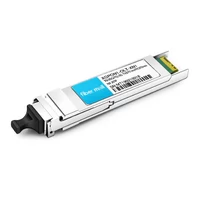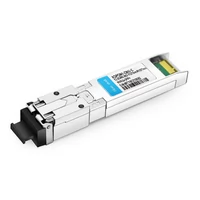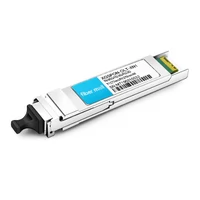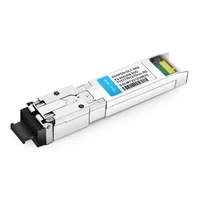The popularity and deployment of 5G or Wi-Fi 6 have posed a huge challenge to PON, the main technology to support enterprise and home networks. However, 10G PON is embracing its own age in FTTH(Fibre To The Home) and FTTB(Fiber To The Building). This article presents the evolution of 10G PON technology, discusses the 10G PON standard, and analyzes the key technologies of the 10G PON component.
Table of Contents
Toggle1. What is PON, 10G EPON and 10G GPON
PON stands for Passive Optical Network referring to the optical distribution network (ODN) between OLT (optical line terminal) and ONU (optical network unit) without any active electronic equipment. The PON network adopts a single-fiber bidirectional optical access network with a point-to-multipoint architecture and is composed of an optical line terminal (OLT) on the network side, an optical distribution network (ODN), and an optical network unit (ONU) on the external sides (subscriber or clients).

Figure1: Diagram of PON Network Topology
10G EPON is a type of passive optical network corresponding to the standard transmission of 10-Gbit/s Ethernet stipulated by IEEE 802.3av. There are two configurations supported by this standard version: one is symmetric, operating at a 10 Gbit/s data rate in both directions, and the other is asymmetric, operating at 10 Gbit/s in the downstream (provider to the customer) direction and 1 Gbit/s in the upstream direction. Compared with 10G GPON, 10G EPON has a stronger splitting capacity with a splitting ratio of 1:128 and is able to serve more users.
10G-PON (also known as XG-PON) is a 2010 computer networking standard for data links. There is one configuration for 10G-PON with asymmetrical bandwidth of uplink and downlink (uplink 2.5Gbps, downlink 10Gbps). Starting at the central office, one single-mode optical fiber strand runs to a passive optical splitter near the outer environment where the splitting devices divide the optical power into a few separate paths to the subscriber or client.
2. Background of 10G PON Market
In the early days, EPON and GPON were generally adopted by telecom operators around the world, including Japan’s NTT, South Korea’s KT, China’s China Telecom (CT), and China Unicom (UT) in the Asia-Pacific region. Considering time and cost, operators first adopt EPON, a more mature technology, for fiber-to-the-home construction. Among them, Japan has built a larger number of EPON networks, using the fiber-to-the-home(FTTH) network as the main wired broadband access network. NTT currently has more than 18 million users, and Taiwan Chunghwa Telecom began to introduce EPON equipment in 2007.

Figure 2: Application Diagram of PON Network
3. Evolution of 10G EPON & 10G GPON
GPON is a PON standard technology promoted by International Telecommunication Union Telecommunication Standardization Department(ITU-T). With the improvement of GPON specifications and the growing maturity of equipment, telecom operators in Europe and the United States have chosen to adopt GPON technology, such as Verizon in the United States, France Telecom (FT), British Telecom (BT), Deutsche Telekom ( Major players such as DT) and Telecom Italia (TI). Except for China Mobile, telecommunication operators in China such as China Telecom and China Unicom are also building GPON networks.
Although the GPON has a short history, it is developing at a rapid pace and is expected to surpass EPONdue to its features such as higher speed and standardization. According to a survey by market research firm Ovum, GPON optical line terminal (OLT) shipments had exceeded EPON to become the mainstream pon technology in 2012.
ITU-T is working with FSAN (Full Service Access Network) organization to develop standards for GPON and NG-PON(Next Generation PON). ITU-T successively issued the G.987 series standard documents for XG-PON(10-Gigabit-capable Passive Optical Network) from 2010 to 2012. The IEEE 802.3av standard for the 10G EPON was launched by the Institute of Electrical and Electronic Engineering (IEEE) in 2009.

Figure 3: Road map of PON Standard and its Large-scale Deployment
As for actual network construction, the construction of 10G-EPON has been increasing and is expected to continuously grow in the next few years. It is said that China Telecom has been wholesaling 10G EPON OLT(optical line terminal)products. Though the construction of XG-PON is moving on at a low speed affected by its technological development and the NG-PON2 standard formulated by ITU-T, it has begun to be deployed massively so far.
4. Standard for 10G-EPON
IEEE 802.3av is the standard for 10G-EPON and It inherits the EPON IEEE 802.3ah standard with an alteration of the increasing transmission rate. 10G EPON operates at 10 Gbit/s in the downstream (provider to the customer) direction and 1 Gbit/s or 10Gbit/s in the upstream direction. In the PCS layer (Physical Coding Sublayer), the 10Gbit/s rate is based on the point-to-point 10G Ethernet standard using 64B/66B encoding, and the 8B/10B encoding method like EPON is applied to the 1Gbit/s upstream. The Forward Error Correction (FEC) coding of 10G EPON is a mandatory function.

Figure 4: Symmetric & Asymmetric Configuration of 10G-EPON
The RS (Reed-Solomon) coding parameter used by 10G EPON is different from that of EPON because the former has upgraded its error correction capability to 16 bytes. 10G-EPO basically follows the Multi-Point Control Protocol (MPCP) protocol of the EPON system, accelerating the maturity and market entry of 10G-EPON equipment.10G EPON is evolving on at a smooth pace on the basis of shared demand on the Optical Distribution Network (ODN). When EPON and 10G-EPON are co-constructed, wavelength division multiplexing (WDM) technology is applied in 10G-EPON to filter EPON and 10G-EPON optical signals at different optical wavelengths.
5. Standard for 10G GPON
● The 2 Periods of NG-PON
In terms of ITU-T, NG-PON went through two stages, one is the NG-PON1 which extends the GPON standard and is compatible with the existing ODN, and the other is the NG-PON2 stage which is free from the existing GPON standards and network restrictions. XG-PON belongs to the NG-PON1, and its asymmetric system (upstream 2.5Gbit/s, downstream 10Gbit/s) is called XG-PON1 while its symmetric system with upstream of 10Gbit/s and downstream of 10Gbit/s is XG-PON2 also called XGS-PON subsequently. However, considering the actual application requirements, the standard formulation of XG-PON2 came to an end, and XG-PON, for which the standard was stipulated subsequently, is an asymmetric passive optical network system called.
In addition, ITU-T expands based on the GPON ONT management control interface (OMCI) to form a new OMCI standard G.988, which serves as the ITU-T optical access network terminal management basic standard. XG-PON is fundamentally an advanced version of G-PON with performance enhancement in high speed, great divergence ratio, and network evolution to serve more users and provide users with higher bandwidth.

Figure5: Symmetric & Asymmetric Configuration of 10G-GPON
● Technical Characteristics for 10G GPON
10G GPON(also known as XG-PON)’s general and physical requirements are specified by G. 987.1 and G.987.2 standards. The data rate of XG-PON is 2.5Gbit/s upstream and 10Gbit/s downstream, and the line code is NRZ (Non-Return to Zero) code. The technology that 10G GPON applies to the multi-task transmission between OLT and optical network unit (ONU) equipment is the same as that of GPON. Both are time-division multiple access (TDMA) modes for upstream and TDM for downstream. However, the optical split ratio supported by XG-PON is at least 1:64, which supports more ONUs than GPON.
The Transmission Convergence (TC) layer standard of XG-PON is standardized in G.987.3, while its XGTC (XG-PON Transmission Convergence) layer architecture is consistent with that of the GPON. But the technology specification on XGTC has to be amended in order to function normally in that there is an increase in Internet access rate and subscribers. The modified standard specified the extension in the bit width of ONU-ID, Port-ID, Alloc-ID, etc., an additional PON-ID, and the increase in encoding lengths of FEC, scrambling, and PLOAM (Physical Layer OAM) information. What’s more, the bandwidth allocation is changed to the word as the unit; and the XGEM (XG-PON Encapsulation Method) letterbox structure also adds encryption-related field width.
6. About Coexistence with 1G PON
Based on the G.987 standard, GPON & XG-PON can simultaneously operate 1 Gbit/s and 10 Gbit/s GPON systems on the same outside plant through WDM(Wavelength Division Multiplexing) components. Similarly, the 802.3av standard places significant emphasis on enabling the simultaneous operation of 1 Gbit/s and 10 Gbit/s EPON systems. In order to allow XG-PON and 10G-EPON to co-exist with 1G PON and 1G EPON respectively in the ODN, the design must consider the evolution and coexistence of the old and new systems; thus the design of optical components is particularly important.

Figure 6: Diagram of GPON and XG-PON coexistence
Issues like the update on downstream and upstream speeds of up to 10 Gbit/s (gigabits per second), how to choose a laser light source to avoid the chirp phenomenon, and How to achieve a stable and balanced light output signal under a 70℃ environment are critical factors affecting the performance of OLT optical transceiver modules. Among them, The OLT’s signal reception would require more expensive burst-mode lasers on optical network terminals (ONTs) to deliver the upstream transmission speed. Figure 1 presents the GPON and XG-PON coexistence network in G.987.
7. Wavelength Allocations of 10G PON
Each transmission standard uses its own wavelength range. The upstream center wavelength of 10G-EPON is configured at 1270 nm and 1310nm. Considering the intercommunication with existing EPON, the upstream 1Gbit/s center wavelength is configured at 1310nm, the center 10Gbit/s wavelength at 1270nm, and downstream at 1577nm. As for XG-PON, The upstream center wavelength is allocated at 1270nm with downstream at 1577nm, which is the same as the 10G/10G system of 10G-EPON. Figure 2 depicts the Wavelength allocations for GPON, XG-PON / 10G-EPON.

Figure 7: Wavelength allocations for GPON, XG-PON, 10G-EPON
8. Optical Devices of 10G PON
The key components of PON equipment are optical transceiver modules and PON MAC chips. The PON optical transceiver module is an optical component of the optical network, which is composed of a laser, a driver, an amplifier, a clock data recovery circuit (Clock Data Recovery, CDR), and a serializer/deserializer (Serializer/Deserializer, SerDes), etc.
The PON MAC chip is a processing chip for PON signal data. The PON MAC of 10G-EPON has already been supplied with special application integrated circuit (ASIC) chips, which are mostly field-programmable gate arrays (FPGAs). But this has been able to meet the demand for functions and performance. As for XG-PON which is evolving at a slow pace, the G.987standard defines 4 optical power budgets that meet the application requirements of different ODN levels. These four specifications are shown in Figure 3. Among them, the maximum channel insertion loss is 35dB of E2 class, indicating that XG-PON has strict requirements for optical transceiver modules. Therefore, the XG-PON optical transceiver modules will play an important role in the whole passive optical network (10G-GPON) system.
|
XG-PON Power Budget By G.987 |
||||
|
Channel Insertion Loss (dB)
|
Power Class |
|||
|
N1 Class |
N2 Class |
E1 Class |
E2 Class |
|
|
Min Loss |
14dB |
16dB |
18dB |
20dB |
|
Max Loss |
29dB |
31dB |
33dB |
35dB |
Figure 8: Table of Optical Power Budget Specifications for 10G-GPON
9. Techniques of Optical Devices in 10G PON
● Techniques of Optical Transceiver
Currently, most of the marketed XG-PON OLT optical transceiver modules belong to the N2 class in terms of channel insertion loss(dB), which is divided into N2a and N2b with the output power of +4~+8dBm and +10.5~+12.5dBm respectively. XG-PON OLT optical modules work at a wavelength range from 1575nm to 1580nm, within which the laser light source can transmit 20 kilometers (km).
Figure 9: FiberMall XG-PON OLT Optical Transceiver
External Modulation Laser (EML) is usually designed in the module to avoid the chirp through external modulation. Also, the technology of semiconductor external modulators used with semiconductor laser light sources has been continuously improved in recent years. The external modulation laser formed integrally with the laser shared substrate has reached a mature stage in performance and quality with its biggest advantage of small size and is easy to pack.
● Techniques of Optical Modulator in 10G PON
Laser’s external modulation refers to parameters changing with signal modulation. When a laser is inserted into an external modulator, the output light intensity and other parameters change by using the electro-optical or phase difference in the modulator. Since the laser only works in a static DC state, the laser’s external modulation can reduce chirp and improve signal transmission performance. At present, the external optical modulators applied to the intermediate-long distance transmission in the 10Gbit/s optical communication system are mostly EAMs and MZMs. The former is short for semiconductor electro-absorption Modulator using electro-optical effect and the latter is Semiconductor Mach-Zehnder Modulator (MZM) using phase difference effect.
EAM is based on the Franz-Keldysh effect named after the German physicist Walter Franz and Russian physicist Leonid Keldysh uses voltage to modulate the intensity of light and applies an electric field with a reverse bias voltage to deform the energy level of EAM to achieve the light modulation by absorbing incident illumination. Specifically speaking, the laser diode (LD) and EAM are made on the same substrate. Such a designed structure has the advantages of high modulation rate, low driving voltage, and small size, enabling it to integrate with semiconductor laser and reducing the package cost. Therefore, this kind of external light modulator has gained popularity in the actual application.

Figure 10: Diagram of 10G EPON OLT & ONU
Mach-Zehnder Modulator uses the change of phase difference to achieve optical modulation. The method works as follows: first, an inserted light source was divided into two paths; then the separated optical signals are re-integrated at the output end; finally, the phase adjustment will be achieved by an external bias voltage. This modulation mode can reduce the chirp parameter to a small value approaching zero, which makes it perfect for high-speed and long-distance signal transmission over optical fiber. But it fails to attract manufacturers’ much attention due to its high cost.
● Techniques of Optical Driver in 10G PON
For 10Gbit/s optical transceiver modules, high temperature is another key factor in addition to laser diode bandwidth, chirp, and dispersion. In the early days, the immature technologies applied in laser diodes and ICs caused severe thermal effects, which not only degraded the quality of the laser diodes but also increased PD (PIN Detector) noise. Furthermore, an extra high temperature may reduce the dynamic range of optical reception (Dynamic Range), and shorten the transmission distance.
At present, some of the XG-PON OLT optical transceiver modules are XFP (10 Gigabit Small Form Factor Pluggable), requiring a drive current of the DFB-LD and an external modulation and temperature control system. The bias current that DFB-LD must provide is more than three times that of DML. As a consequence, the heat accumulated in the entire XFP per unit time is difficult to release at room temperature. How to achieve a stable balance of light output signals in an environment of 70°C really poses a big challenge to the manufacturer’s technology.
Figure 11: FiberMall 10G EPON ONU Optical Transceiver
● Techniques of Optical Amplifier
Generally, the signal receiving in the optical transceiver modules is realized through an optical receiver with a TIA (TransImpedance Amplifier) and a limiting amplifier. The optical transceiver with a TIA converts the received optical signal into a voltage signal, then transmits it to the limiting amplifier, and finally, the serial data is output after being amplified by the limiting amplifier.
In order to improve the dynamic frequency response in ONU, an average reading detector with Auto Gain Control(AGC)technique is designed in 10G EPON OLT/ONU optical transceivers. However, GPON optical transceivers receive the optical signals in burst mode. The transceiver’s response time to different ONUs is less than 256ns. In this case, an automatic gain control method with a short response time must be used to meet the requirement of 256ns. A peak detector with automatic gain control is one of the methods to process the circuit.
10. What is XGS-PON?
Both XG-PON and XGS-PON belong to the GPON series. XGS-PON is the technological evolution of XG-PON.
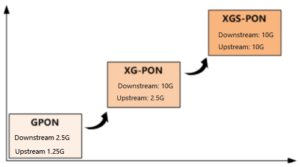
Figure12: The technological evolution of XG-PON
Both XG-PON and XGS-PON are 10G PONs. The main difference is that XG-PON is an asymmetric PON, and the uplink/downlink rate of the PON port is 2.5G/10G; XGS-PON is a symmetrical PON, and the uplink/downlink rate of the PON port is 10G/10G.
| Technology | GPON | XG-PON | XGS-PON | |
|---|---|---|---|---|
| Technical standard | G.984 | G.987 | G.9807.1 | |
| Year the standard was published | 2003 | 2009 | 2016 | |
| Line rate(Mbps) | downlink | 2488 | 9953 | 9953 |
| uplink | 1244 | 2488 | 9953 | |
| Maximum split ratio | 128 | 256 | 256 | |
| Maximum transmission distance (km) | 20 | 40 | 40 | |
| Data encapsulation | GEM | XGEM | XGEM | |
| Available bandwidth(Mbps) | downlink | 2200 | 8500 | 8500 |
| uplink | 1000 | 2000 | 8500 | |
| Operating central wavelength(nm) | downlink | 1490 | 1577 | |
| uplink | 1310 | 1270 | ||
Table 1: Comparisons of XG-PON, XGS-PON, and G-PON
The main PON technologies currently used are GPON and XG-PON, both of which are asymmetric PONs. Taking a first-tier city as an example, the uplink traffic of the OLT is only 22% of the downlink traffic on average. Therefore, the technical characteristics of the asymmetric PON basically match the needs of users. More importantly, the upstream rate of an asymmetric PON is low, and the cost of transmitting components such as lasers in the ONU is low, so the equipment price is correspondingly low.
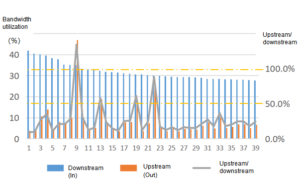
Figure 13: Second-level peak bandwidth utilization of some OLT uplink circuits in a city
However, the needs of users are diverse. With the rise of services such as live broadcast and video surveillance, there are more and more scenarios where users pay more attention to the uplink bandwidth, while the dedicated line for inbound customers needs to provide symmetrical uplink/downlink circuits. These services promote the demand for XGS-PON.
XGS-PON is the technical evolution of GPON and XG-PON and supports the hybrid access of ONUs of GPON, XG-PON, and XGS-PON.
-
Coexistence of XGS-PON and XG-PON
Like XG-PON, the downlink of XGS-PON adopts broadcast mode, and the uplink adopts TDMA mode.
Since the downstream wavelength and downstream rate of XGS-PON and XG-PON are the same, the downstream of XGS-PON does not distinguish between XGS-PON ONU and XG-PON ONU. The optical splitter broadcasts the downstream optical signal to each XG(S)-PON (XG-PON and XGS-PON) ONU in the same ODN link, and each ONU chooses to receive its own signal and discard other signals.
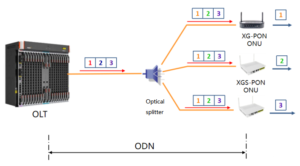
Figure 14
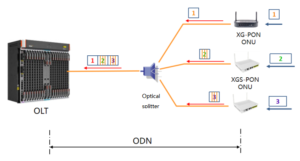
Figure 15
It can be seen that XGS-PON naturally supports hybrid access of two ONUs, XG-PON, and XGS-PON.
-
Coexistence of XGS-PON and GPON
Since the uplink/downlink wavelengths are different from that of GPON, XGS-PON adopts the Combo solution to share ODN with GPON. The Combo optical module of XGS-PON integrates GPON optical module, XGS-PON optical module, and WDM combiner.
In the upstream direction, after the optical signal enters the XGS-PON Combo port, the WDM filters the GPON signal and the XGS-PON signal according to the wavelengths, and then sends the signals to different channels.
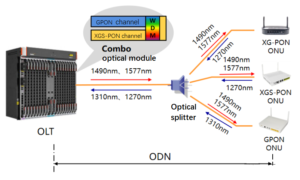
Figure 16: The Combo optical module of XGS-PON integrates GPON optical module, XGS-PON optical module, and WDM combiner
In the downstream direction, the signals from the GPON channel and the XGS-PON channel are multiplexed through WDM, and the mixed signal is downstream to the ONU through the ODN. Due to the different wavelengths, different types of ONUs select the required wavelength through the internal filter to receive the signal.
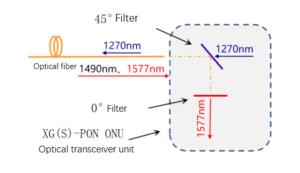 Figure 17: ONUs select the required wavelength through the internal filter to receive the signal
Figure 17: ONUs select the required wavelength through the internal filter to receive the signal
Since XGS-PON naturally supports coexistence with XG-PON, the Combo solution of XGS-PON supports the mixed access of three types of ONUs, namely GPON, XG-PON, and XGS-PON. The Combo optical module of XGS-PON is also called a three-mode Combo optical module (the XG-PON Combo optical module is called a two-mode Combo optical module because it supports the mixed access of GPON and XG-PON ONUs).
Conclusion
As demand for network speed continues to grow, new and faster technologies are spawned from the existing standards. 10G-PON is the next-generation ultra-fast capability for G-PON providers, designed to coexist with installed G-PON user equipment on the same network. EPON defined by IEEE and GPON defined by ITU is both embracing an era of 10G PON. The current mainstream PON technologies used in FTTH (fiber to the home) are EPON and GPON, and 10G PON technology is mainly used in (Fiber To The Corridor).
Affected by equipment cost and equipment maturity, currently, the equipment price of XGS-PON is much higher than that of XG-PON. Among them, the unit price of OLT (including the Combo user board) is about 20% higher, and the unit price of ONU is more than 50% higher.
Although the inbound private line needs to provide symmetrical uplink/downlink circuits, the actual traffic of most inbound passenger lines is still dominated by the downlink one. There are more and more scenarios where users pay more attention to the upstream bandwidth, however, there is almost no service that cannot be accessed through XG-PON and must be accessed through XGS-PON.
Due to the good compatibility of the XGS-PON Combo solution, the unit price of the XGS-PON OLT (including the Combo user board) is not much higher than that of the XG-PON. A small amount of XGS-PON OLT equipment can be deployed in first- and second-tier cities and provincial capital cities (the headquarter upstream traffic of inbound private lines is usually high), and XGS-PON ONU is equipped according to the actual uplink bandwidth requirements of users.
Related Products:
-
 10GEPON-OLT-XGS Symmetric 10GEPON OLT and 1.25G EPON OLT in an XFP Housing TX: 1577nm (10.3G)/1490nm (1.25G) RX: 1270nm (10.3G)/1310nm (1.25G) PR30 SC DDM Optical Transceivers
$240.00
10GEPON-OLT-XGS Symmetric 10GEPON OLT and 1.25G EPON OLT in an XFP Housing TX: 1577nm (10.3G)/1490nm (1.25G) RX: 1270nm (10.3G)/1310nm (1.25G) PR30 SC DDM Optical Transceivers
$240.00
-
 10GEPON-OLT-SGCE Symmetric 10GEPON OLT and 1.25G EPON OLT in an SFP+ Housing TX 1577nm (10.3G)/1490nm (1.25G) RX 1270nm (10.3G)/1310nm (1.25G) PR30 SC DDM Optical Transceivers
$225.00
10GEPON-OLT-SGCE Symmetric 10GEPON OLT and 1.25G EPON OLT in an SFP+ Housing TX 1577nm (10.3G)/1490nm (1.25G) RX 1270nm (10.3G)/1310nm (1.25G) PR30 SC DDM Optical Transceivers
$225.00
-
 10GEPON-ONU-SC Symmetric 10GEPON ONU SFP+ TX-10.3G/RX-10.3G TX-1270nm/RX-1577nm PR30 SC DDM 0°C~70°C Optical Transceivers
$38.00
10GEPON-ONU-SC Symmetric 10GEPON ONU SFP+ TX-10.3G/RX-10.3G TX-1270nm/RX-1577nm PR30 SC DDM 0°C~70°C Optical Transceivers
$38.00
-
 XGPON1-OLT-XN1 XG-PON1 OLT XFP TX-9.95G/RX-2.5G TX-1577nm/RX-1270nm N1 SC DDM Optical Transceivers
$237.00
XGPON1-OLT-XN1 XG-PON1 OLT XFP TX-9.95G/RX-2.5G TX-1577nm/RX-1270nm N1 SC DDM Optical Transceivers
$237.00
-
 XGPON1-ONU-C XG-PON1 ONU SFP+ TX-2.5/RX-9.95G TX-1270nm/RX-1577nm N1/N2a SC DDM 0°C~70°C Optical Transceivers
$36.00
XGPON1-ONU-C XG-PON1 ONU SFP+ TX-2.5/RX-9.95G TX-1270nm/RX-1577nm N1/N2a SC DDM 0°C~70°C Optical Transceivers
$36.00
-
 XGSPON-OLT-XN1 XGSPON OLT XFP TX-9.95G/RX-2.5G/RX-2.5G TX-1577nm/RX-1270nm N1 SC DDM Optical Transceivers
$1095.00
XGSPON-OLT-XN1 XGSPON OLT XFP TX-9.95G/RX-2.5G/RX-2.5G TX-1577nm/RX-1270nm N1 SC DDM Optical Transceivers
$1095.00
-
 XGSPON-ONU-C XGSPON ONU SFP+ TX-9.95G/RX-9.95G TX-1270nm/RX-1577nm N1/N2 SC DDM 0°C~70°C Optical Transceivers
$75.00
XGSPON-ONU-C XGSPON ONU SFP+ TX-9.95G/RX-9.95G TX-1270nm/RX-1577nm N1/N2 SC DDM 0°C~70°C Optical Transceivers
$75.00
-
 FiberMall XGSPON-OLT-SN2 XGSPON OLT SFP+ TX-9.95G/RX-9.95G, 2.488G Tx-1577nm/Rx-1270nm SN2 SC UPC DDM Optical Transceivers
$315.00
FiberMall XGSPON-OLT-SN2 XGSPON OLT SFP+ TX-9.95G/RX-9.95G, 2.488G Tx-1577nm/Rx-1270nm SN2 SC UPC DDM Optical Transceivers
$315.00




